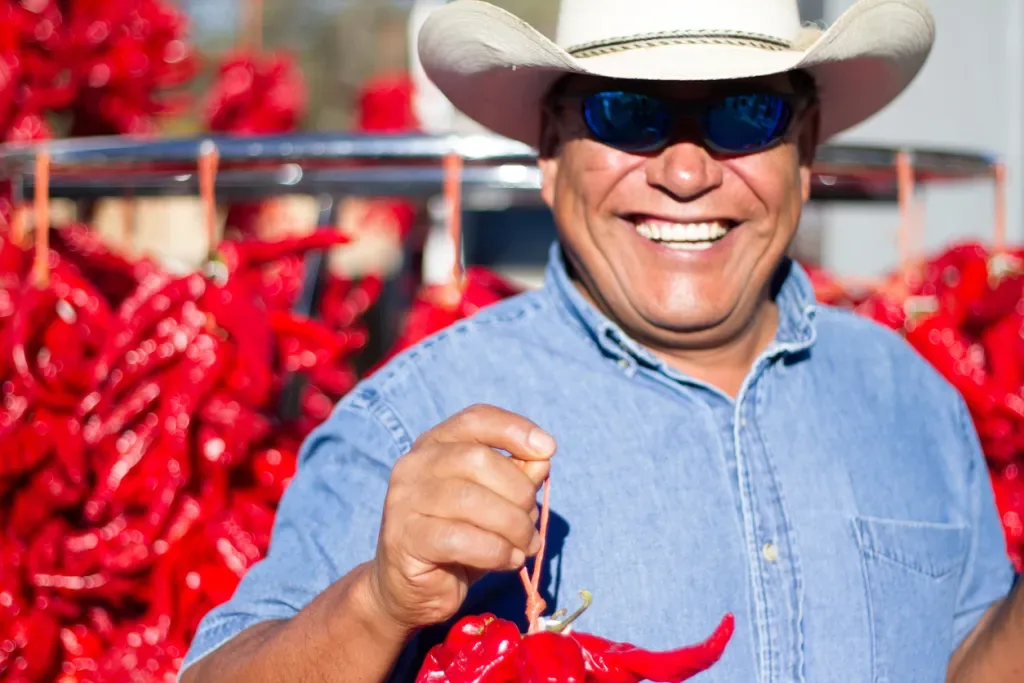Ristras are a staple of Southwestern decor. You can find them in restaurants, stores, markets, and even people’s homes.
This decor has been around for hundreds, even thousands, of years, and they’re more than eye candy. They’re edible, have tons of health benefits, and might even fill your home with good luck.
Today we’ll dive deeper into this spicy souvenir.
Let’s check it out!

What Is a Ristra?
Even if you don’t know the word, you probably know what a ristra is. You’ve probably seen these bundles of chiles, usually tied to a string in a vertical wreath. Because sunlight helps them dry naturally without decomposing, you’ll frequently see them in sunny spots. Once dry, they can be used either for decoration or access to a quick, spicy snack. They also make excellent homemade seasoning blends.
Although red and green chiles are the most popular items used for these edible garlands, they aren’t the only ones. You can make them with dozens of other food items. In fact, you can make one from just about anything. Ristra is the Spanish word for “string,” so you can make one from any food you can tie up!
Where Are Ristras Popular?
You’ll find ristras in many places across the Southwest. But this humble garland originated in New Mexico.
The Land of Enchantment is home to the New Mexico chile, the classic variety that adorns the wreaths. These thrive across the state, with its dry air and plentiful sunshine. Young peppers are green, but as the fruit matures, it gets its well-known red color.
Inhabitants of the region have enjoyed these spicy treats for thousands of years. You could lay the chiles flat in the sun to dry before using them in various dishes. However, this made them susceptible to vermin, pests, and other contaminants. Hanging them from a string provided a solution that allowed you to dry them without worrying about animals, insects, or bacteria.
What Do The Wreaths Symbolize?
Ristras aren’t just for decor or cooking. To many people, these spicy garlands carry special meaning.
Many people believe they bring luck to the families who hang them. Others think they promote good health and healing. And those folks may be right. As the drying chiles age and begin turning red, their vitamin A concentration rises sharply. They’re also good sources of vitamins E and B. And just like any spicy food, the capsaicin in the chiles also carries some health benefits.
What Kinds of Peppers Are Used in Ristras?
New Mexico chiles are the most popular type used for ristras. They’re also the most traditional choice for pepper garlands. But you can make the garlands out of other varieties too. Some folks use de arbol or Anaheim.
Whatever variety you choose, allow them to dry a bit before creating your wreath. Very young green ones need air and space. If you tie them together too soon, they’ll just rot and shrivel.
While peppers are the most common choice, you can make them using many foods. Garlic bulbs are another great option for this craft. Really, you can use any vegetable that dries well.
Speaking of New Mexico chiles: What Is a Hatch Chile (and Where Can You Find Them?)
Are Ristras Edible?
You can absolutely eat the peppers from your ristras. In fact, many New Mexico residents would be shocked to know that some people don’t eat these delicious snacks.
The chiles can be used for dozens of tasty recipes. A spicy sauce is an obvious choice, which will take on op a unique, smoky flavor. You could use them in chili or many soups for added kick and taste. And, of course, you can grind them to make homemade flakes.
However, use caution if you’re buying a ristra from a store. While some are safe to eat, others are purely decorative and may have been treated with a preservative. You definitely don’t want to eat toxic chemicals!

How Long Do Ristras Last?
They’re pretty, bring luck and health, and you can eat them, too. Is there anything a ristra can’t do? Maybe one thing: while they last a long time, they don’t last forever.
These dried chiles remain edible for up to three years in the correct climate. Garlands treated with preservatives can last as long as five to ten years. Desert areas like New Mexico and Arizona have exactly the right temperature and humidity levels to preserve the peppers.
But outside a desert climate, these wreaths don’t last nearly as long. High humidity may cause rapid decomposition or mold problems. They also face threats like bugs, birds, and other pests.
To extend the life of your edible ristra, hang it in a cool, dark place. You can put it outside, but keep it out of the wind and in partial sunlight, if possible.
The Perfect Southwestern Souvenir
The ristra is an essential part of New Mexico’s cultural heritage. These bright pepper wreaths are so well-known it’s impossible not to think of the Land of Enchantment when you see one.
So, the next time you’re in the Southwest, pick up a few to take home. And if you can’t get to the Southwest anytime soon, try making your own! Whether you use garlic, chiles, or any other veggie, you’ll have a decorative craft that’s both homey and delicious.